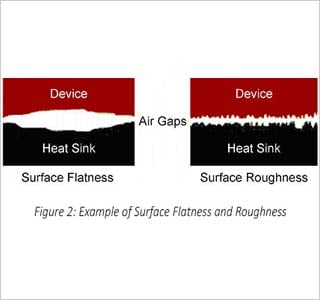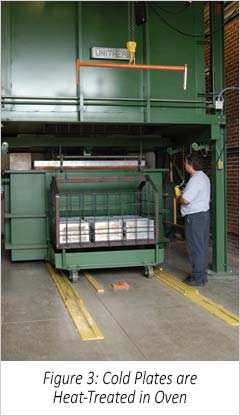在液冷板制造中使用不同技术的影响
The two biggest cost drivers in cold plate manufacturing are thermal performance requirements and annual demand, which generally thermal engineers and manufacturing engineers have little or no control over. However, you can reduce costs by understanding how roughness, flatness, hardness, surface topography, mounting features, and liquid connections specifications can all affect the cost of a cold plate. By involving your cold plate manufacturer early in the design process, you’ll be able to identify the manufacturing cost drivers and select the most cost effective design.
大多数冷板由铝制成,但一些新技术使用铜。尽管铜具有更好的导热性,但铝的使用更为广泛,因为铝通常更便宜、更轻且更易操作。对铜进行机加工非常困难且昂贵。一般而言,如果铝符合热性能规格,将是最佳的使用材料。
Two of the most popular aluminum cold plate technologies are tubed and vacuum-brazed (See Figure 1). Tubed cold plates are usually copper or stainless steel tubes pressed into a channeled aluminum extrusion. They are cost-effective and offer good bulk heat removal for low-to-medium watt densities. Vacuum-brazed cold plates consist of two plates metallurgically bonded together with internal fin. They are available in all sizes and offer extremely high performance, making them ideal for applications where heat loads are concentrated. Labor time is limited with both tubed and vacuum-brazed cold plate technologies. For that reason, U.S. cold plate manufacturers tend to be competitive with offshore manufacturers for moderate volumes. The lower labor cost reduction from buying offshore is typically offset by shipping and customs costs, and additional inventory associated with long transport times. The threshold quantity for offshore savings is usually about 10,000 cold plates or more per year.
除上文提及的因素外,铝冷板最大的成本动因是加工时间和额外的加工步骤。冷板制造商通常会产生与加工时间相关的成本,包括机器的折旧费用、电源、耗材和维护费用。因此,冷板在机器中的放置时间越长,成本就越高。每个额外的加工步骤都会进一步增加成本。
挤出与压铸
为了最大程度地减少加工时间并降低成本,应尽可能使用挤出和压铸工艺。挤出是指通过推动金属穿过模具来产生具有固定横截面的物体。用于新挤出件的模具相对便宜并且挤出尺寸限制在约9英寸(22.86厘米)宽。挤出壁厚必须相对一致,并且任何槽道或部件都必须平直。
您的制造商还可以结合使用挤出和机加工来降低成本。可以对某些部件进行挤出,然后加工更复杂的部件。对于样品设计,另一种方案是加工少量冷板,然后在设计通过验证和确认之后,制造用于挤出的模具。如果您在设计冷板时考虑到挤出部件,这将有助于降低挤出成本。
Another option is to combine casting and machining to make cold plates. For instance, if the casting is not flat enough, a secondary operation to get the cold plate to the required flatness specification will be necessary. It is important to note that sand castings are not an option for vacuum-brazed cold plates because most alloys used have a melting temperature below the vacuum-brazing temperature. Their use is strictly limited to tubed cold plates. Obtaining quotes on the two production processes and weighing the pros and cons is recommended.

典型的机加工冷板的表面光洁度为32-64 µin(81-163 µcm),这对于大多数应用是足够的。使用标准机加工中心可将粗糙度降至16 µin(41 µcm),但是这需要更牢固的夹具以减少任何可能出现的颤动,并降低加工头的速度和进给速度。(速度是指切削工具头旋转的速度,进给速度是指加工头在冷板上移动的速度。)降低速度和进给速度会导致加工时间延长,从而增加成本。
Most applications use a thermal interface material (TIM) between the component or board and the cold plate to help to minimize the gaps. A TIM should be as thin as possible, as the relatively high thermal resistance of the TIM greatly overshadows any conductivity improvements from having a smoother surface. Increasing the clamping force of the component or board to the cold plate can also help to offset a higher roughness, but it may increase the stress on the board or component. Clamping stress can also increase the impact of coefficient of thermal expansion (CTE) mismatches as the cold plate and component or board heat up.
表面平整度
表面平整度比表面粗糙度对冷板的热性能影响更大,因为如果冷板不平整,则接触面积大大减小(见图2)。标准平整度规格为0.001英寸/英寸(0.003厘米/厘米)。因此,在测量点的一英寸范围内,冷板的最低点与最高点相差不会超过0.001英寸(0.003厘米)。如果您的规格要求平整度优于0.001英寸/英寸(0.003厘米/厘米),则节省成本的一种方法是指定局部平整度而不是整个板上的严格平整度。例如,如果要在冷板上安装多个绝缘栅双极型晶体管(IGBT),并且每个IGBT在整个基板上需要达到0.001英寸/英寸(0.003 厘米/厘米)的平整度,则应为单个IGBT指定局部平整度,而不是要求整个板达到极高的平整度。
冷板的压平过程通常涉及液压机。可以使用刮削提高平整度。利用刮削,机床将确定冷板的最低点,并刮除最低点处的极少量金属,以及较高区域处尽可能多的金属以获得平整表面。尽管对铝块进行刮削非常容易,但对真空钎焊式冷板或管式冷板的管侧进行刮削却较为困难。为了优化散热性能,真空钎焊式冷板和管式冷板中管的冷却表面通常较薄。如果冷板不平整,则刮削可能过深,导致壁变薄,从而可能变得过于脆弱而无法承受压力,甚至会破裂。您也可以从较厚的冷板开始,以消除泄漏的可能性,但是会牺牲一些性能。

硬度
压铸、挤出或真空钎焊式冷板在加工后非常柔软,通常硬度仅为T0。由于软铝很难加工和处理,因此必须硬化冷板。为了将硬度从T0提高到T4,必须对冷板进行热处理。热处理过程涉及使冷板升至1000°F(538°C),将其在该温度下放置约1小时/英寸冷板厚度(最厚点),然后通过使其迅速冷却来对其进行热冲击。(见图3)。冷却冷板的一种方式是将其直接从熔炉中取出并放入水浴中。为了使冷板硬度从T4提高到T6,必须对冷板进行人工老化。这通过将冷板在300°F-400°F(149°C-204°C)下放置8-16小时来实现。硬度达到T6的冷板非常坚硬并且具有高抗拉强度,这是军事和航空航天应用的典型要求。但对于大多数应用而言,硬度达到T4已足够,选用T6硬度只会增加不必要的成本。安装特征/孔
冷板制造中另一个成本增加因素是孔的增加。一个孔可能使冷板成本增加多达3美元。孔使成本增加的主要原因之一是无法在流体路径中打孔。因此,对于管式冷板,需要在管中制造弯曲部分以容纳孔,并且每制造一个弯曲部分都会增加成本。对于真空钎焊式冷板,必须在流体路径中创建岛,这也意味着要对内部翅片进行放电加工(EDM)。这会极大地增加加工时间,并导致成本上升。
有若干种类型的孔。一种是通孔,从冷板的一侧贯穿到另一侧。第二种是有螺纹的螺纹孔。由于铝相对较软,如果频繁更换组件或板,会缩短螺纹孔的寿命。针对螺纹孔,往往会使用螺纹护套。螺纹护套是坚固的钢制插入件,可为可能需要频繁更换组件的应用增加螺纹强度。通孔只需一种钻孔工艺即可制作,而螺纹孔则需要在同一台机床上安装额外的刀具。螺纹护套需要有螺纹孔以便进行安装,并且螺纹护套的安装是在加工中心之外完成的。总而言之,通孔的成本最低,螺纹护套成本最高。
孔位置和间距的严格公差也会增加成本。合理的公差规格为±0.005英寸(±0.013厘米)。与平整度一样,在可能的情况下指定局部公差可降低成本。对于孔间距相对较远的大型冷板,公差更加难以保持。一个原因在于,由于刀头的行进距离增加,机床公差也会增加。另一个原因在于,机械车间内可能存在高达18°F(10°C)的热梯度,这会使冷板膨胀或收缩多达0.005英寸(±0.013厘米)。通孔最容易指定更严格的公差,因为通孔是利用一种刀具制作的,而螺纹孔的公差不那么容易实现,因为制作螺纹孔需要使用两种刀具。螺纹护套的公差最难实现,因为过程需要螺纹孔,而螺纹护套本身也具有公差。所有的公差加起来使制造更加困难且成本更高。避免小螺纹孔也有助于降低成本。4-40或更小尺寸的孔难以攻丝,因为丝锥会在钻孔过程中断裂。为了最大程度地减少该问题,必须极大地降低机床的运行速度。应对冷板上严格的公差要求的一种方式是增加组件或板中安装孔的尺寸。
液体连接
For liquid connections, straight threaded O-ring female ports generally work best. Other than a welded system, it provides the best sealing at the lowest cost. Plumbing connections, such as a NPT fitting, do not provide the precision needed for components such as cold plates. On a vacuum-brazed cold plate, a male fitting, such as a barbed or beaded fitting, should be avoided because it requires another operation such as welding to attach the fitting. In addition, fittings that extend beyond the cold plate need to be protected during shipment, potentially adding packaging costs. Quick disconnects should only be used when necessary because they can cost as much as $750 per pair. Quick disconnects are required on cold plates or electronics that need to be frequently replaced. They are also required for cold plates that are shipped already charged with cooling fluid. With liquid connections another consideration is the port tolerance. Usually incoming plumbing has some flex to it. A reasonable tolerance is between ±0.030 inch (0.076 cm) and ±0.060 inch (0.152 cm).
设计与制造合作伙伴
Working with a cold plate manufacturer early in a cold plate’s design or being flexible on a build to print design will allow for the greatest amount of cost savings. Although the two biggest cost drivers in cold plate manufacturing are thermal performance requirements and annual demand, there are many other factors over which thermal and/or component engineers have some control. Ensuring that there is a reason for every specification, as every specification may drive up cost, will help to keep costs down. It’s important to determine when roughness, flatness, surface topography, hardness, mounting features and holes, and liquid connections specifications are necessary. In addition, it’s important to realize that there are many alternatives in not only the design, but also the manufacturing processes used, which can save hundreds if not thousands of dollars in manufacturing.
Visit our Liquid Cold Plate Section to learn more about our solutions.






